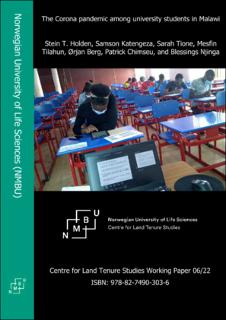| dc.description.abstract | This study provides the initial survey data from a sample of 764 students at the Lilongwe University of Agriculture and Natural Resources (LUANAR), Lilongwe, Malawi. It aims to provide evidence on the extent of exposure to the pandemic among university students, their knowledge and beliefs related to the corona virus and the ways to protect oneself against getting infected, the sources of information that the students rely on, and other factors influencing their knowledge, beliefs, and behavior. The study was undertaken in the period of February-March 2022 during which the fourth wave of the pandemic in the country took place and in this period the omicron variant of the virus dominated.
The result of the study shows that 17.5% of the students reported that they thought they had been infected by the corona virus. But only 23.9% of these had tested themselves for being infected and 27.2% of the students had taken a COVID-19 vaccine. Among those not vaccinated, 42.5% would like to get vaccinated, 21.9% are unsure and the remaining 35.6% would not like to get the vaccine. Astra Zeneca (47.6%) and Johnson & Johnson (53.3%) are the dominating vaccines used.
Most of (95.2%) the students stated that they tried to avoid getting infected by the corona virus during the most recent wave of the pandemic. The use of facemasks was considered most important way to avoid getting infected, followed by distancing, handwashing and avoiding crowded places. Few gave priority to avoiding handshakes and avoiding visiting old people and relatives or reduced the number of contact persons. This could be related to the social setup in Malawi, which revolves around handshakes and visiting family members compared to the global north where handshakes are less common. | en_US |

